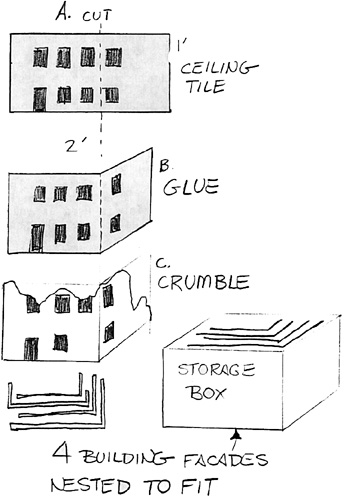As mentioned in PW#8, the Lion's Den is now supplied heavily with a Russian MG platoon. Each new project begins another in a wargamers hobby schedule. And now the LD needs terrain to accompany the new figure collection.
Stalingrad will do nicely as a scenario rich environment for WW2 skirmish wargaming. To create such terrain is an awesome assignment in sculpting a destroyed and decimated landscape. The images I saw in my research were of shell torn buildings, crumpled facades, burnt out hulks of twisted metal factories and rubble strewn everywhere. A scratch builders paradise for the imagination and a cumbersome storage hassle--if mishandled.
My idea for this terrain is to depart from the diorama base building technique used in earlier LD terrain. And create a series of building facades that will nest within each other and none of which will exceed the storage dimensions of a standard copier paper box. (11"x17"x9").
The materials used in this construction will be ceiling tile from Builders Square. One sheet is around $3.00 and can provide enough raw material for four buildings. To seal the surface of the tile, I use All Purpose Joint Compound (Drywall Mud), watered down. To glue all seams use SoBo white glue or a hot glue gun. Paint is used as you see fit. I use acrylic or spray paint. Assorted architectural details can be made of balsa wood, bristol board, or bits and pieces from your scrap box--remember everything is destroyed or in a wrecked condition, neatness won't count.
Begin with the ceiling tile. It starts out 2'x4'. I cut mine into 1'x2' panels, yielding four. Each of these panels will have a building layout scribed into the pliable surface of the tile. To etch into the tile I have used every type of sharp pointed object from needles and paper clips to ball point pens and Swiss army knives.
Choose a building from a picture and notice the texture and layout of the brick pattern. Using a ruler and pencil I draw the plan of the building directly to the tile and then carve it out. When the building is ready to stand up, I cut it vertically on a band saw. The two resulting halves are then glued into the shape of a building corner.
This will create the front and side of our scale facade. Then comes the fun of shell damaging the building. Purposefully and aesthetically pinch off huge chunks of ceiling tile, revealing the destruction and horror of warfare on your miniature building.
Finally, paint and finish the corner facade to look like a war torn shelled building. My plan is to have every building nest into a single copier paper size box. The diagram is the above view of the storage system.

The list of reference works include titles available at the public library.
-
Hastings, Max. The Onslaught: The German Drive to Stalingrad. New York, London: 1984.
Hindley, Ronald. Russia: A Concise History. London: Thames and Hudson Ltd., 1991.
Hoyt, Edwin P. The Battle for Stalingrad 199 Days. Tom Doherty Associates Inc., 1993.
Mayer, S. L. ed. The Russian War Machine 1917-1945. New York: W.H. Smith Publishers Inc., 1977.
Back to Table of Contents Penny Whistle #9
Back to Penny Whistle List of Issues
Back to MagWeb Master Magazine List
© Copyright 1994 by Lion's Den Publications.
This article appears in MagWeb (Magazine Web) on the Internet World Wide Web.
Other military history articles and gaming articles are available at http://www.magweb.com